2. Attention mechanism and Seq2seq model
2.1. Attention mechanism
2.1.1. concept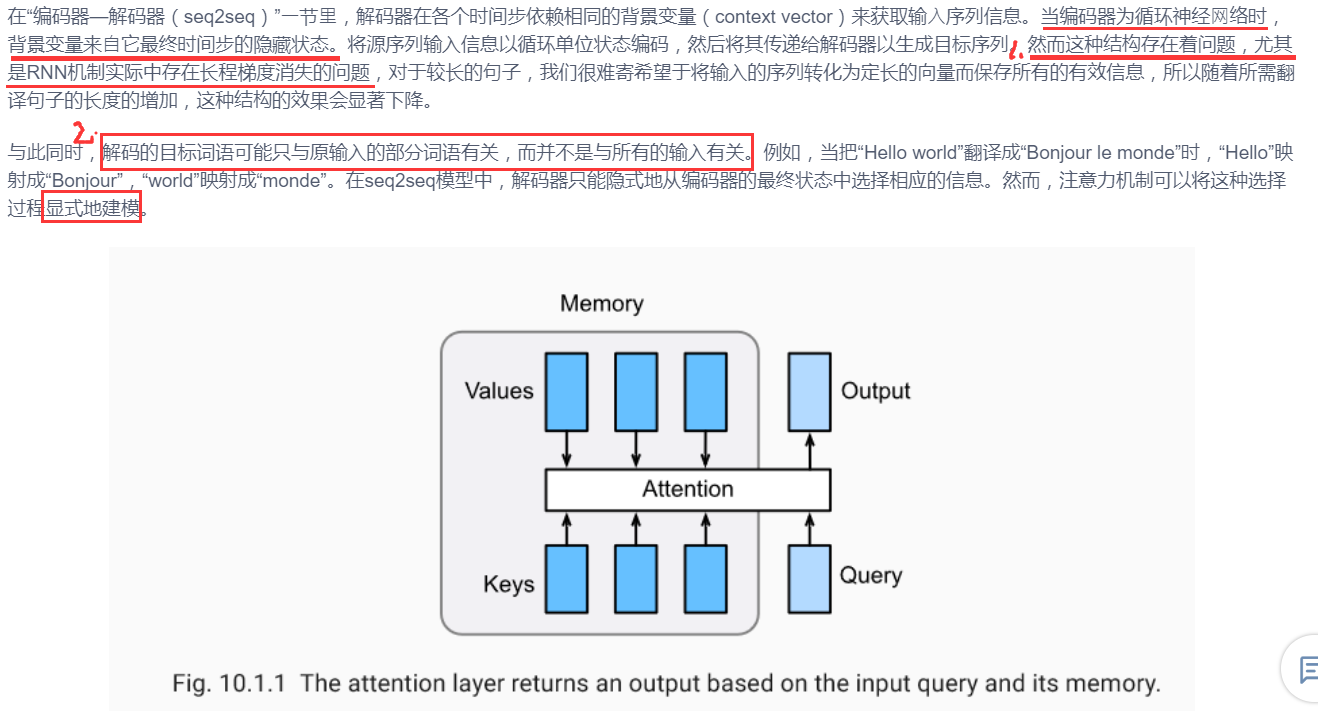
2.1.2. framework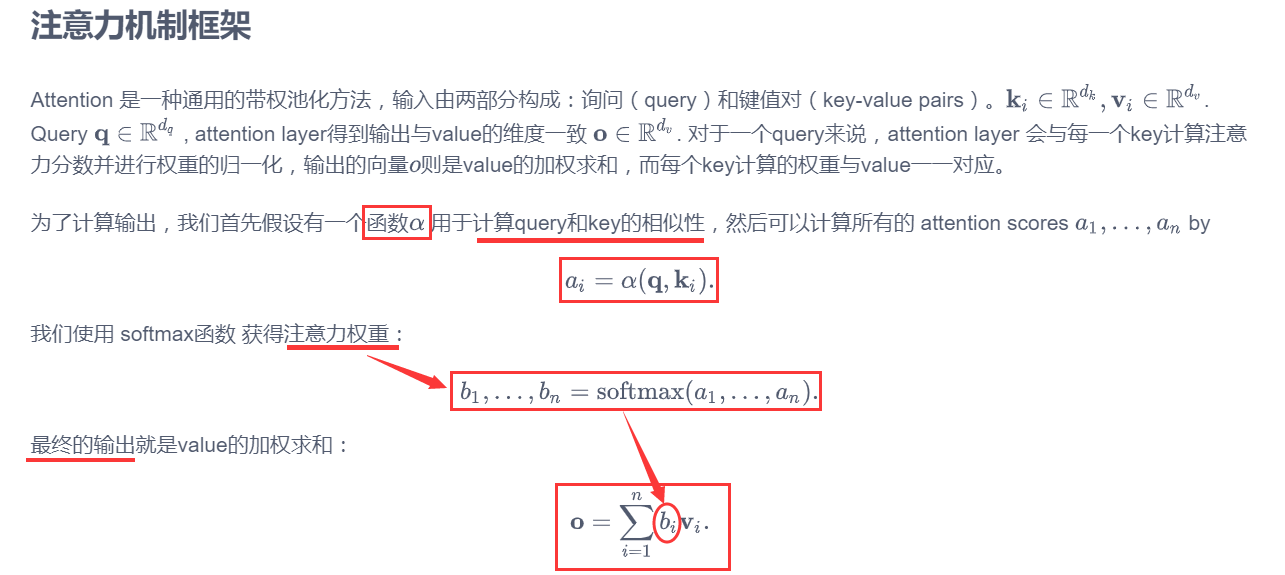
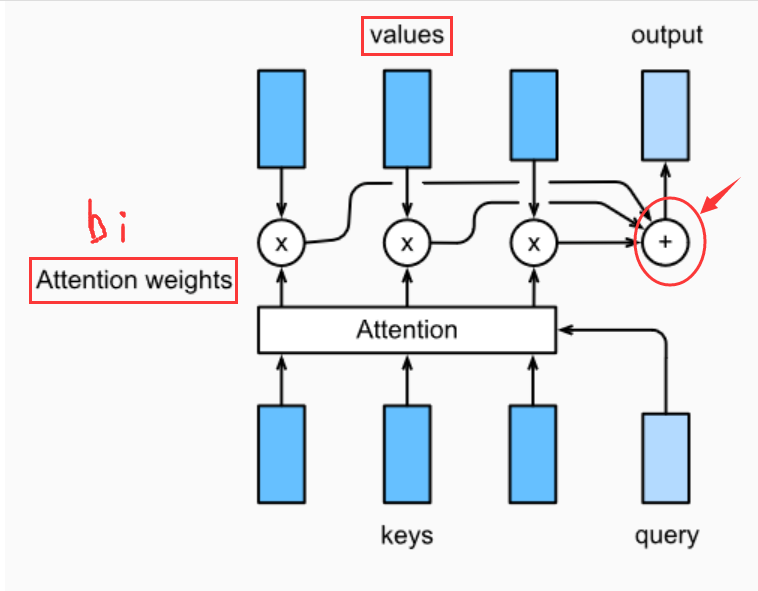
The difference between different attention layers lies in the choice of score function. In the rest of this section, we will discuss two commonly used attention layers, dot product attention and Multilayer Perceptron Attention. Then we will implement a seq2seq model with attention and train and test it on English French translation corpus.
import math import torch import torch.nn as nn import os def file_name_walk(file_dir): for root, dirs, files in os.walk(file_dir): # print("root", root) # Current directory path print("dirs", dirs) # All subdirectories under the current path print("files", files) # All non directory sub files under the current path file_name_walk("/home/kesci/input/fraeng6506")
shielding operation of softmax
Effectively eliminate the interference of "irrelevant information of padding position"
• SequenceMask
def SequenceMask(X, X_len,value=-1e6): maxlen = X.size(1) #print(X.size(),torch.arange((maxlen),dtype=torch.float)[None, :],'\n',X_len[:, None] ) mask = torch.arange((maxlen),dtype=torch.float)[None, :] >= X_len[:, None] #print(mask) X[mask]=value return X
• masked_softmax
def masked_softmax(X, valid_length): # X: 3-D tensor, valid_length: 1-D or 2-D tensor softmax = nn.Softmax(dim=-1) if valid_length is None: return softmax(X) else: shape = X.shape if valid_length.dim() == 1: try: valid_length = torch.FloatTensor(valid_length.numpy().repeat(shape[1], axis=0))#[2,2,3,3] except: valid_length = torch.FloatTensor(valid_length.cpu().numpy().repeat(shape[1], axis=0))#[2,2,3,3] else: valid_length = valid_length.reshape((-1,)) # fill masked elements with a large negative, whose exp is 0 X = SequenceMask(X.reshape((-1, shape[-1])), valid_length) return softmax(X).reshape(shape) # Use masked_softmax(torch.rand((2,2,4),dtype=torch.float), torch.FloatTensor([2,3]))
two levels of attention
• dot product attention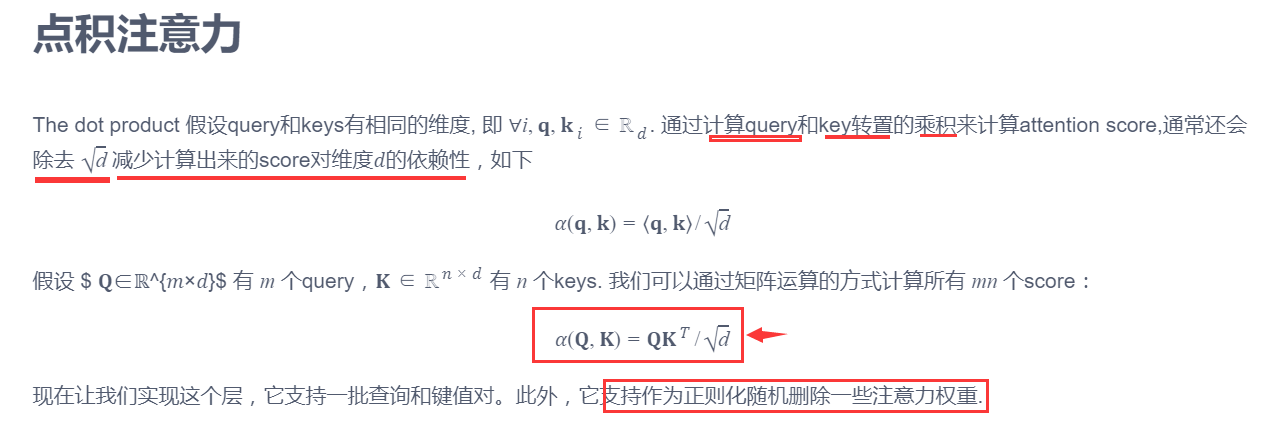
# Save to the d2l package. class DotProductAttention(nn.Module): def __init__(self, dropout, **kwargs): super(DotProductAttention, self).__init__(**kwargs) self.dropout = nn.Dropout(dropout) # query: (batch_size, #queries, d) # key: (batch_size, #kv_pairs, d) # value: (batch_size, #kv_pairs, dim_v) # valid_length: either (batch_size, ) or (batch_size, xx) def forward(self, query, key, value, valid_length=None): d = query.shape[-1] # set transpose_b=True to swap the last two dimensions of key scores = torch.bmm(query, key.transpose(1,2)) / math.sqrt(d) attention_weights = self.dropout(masked_softmax(scores, valid_length)) print("attention_weight\n",attention_weights) return torch.bmm(attention_weights, value)
Test:
Now we have created two batches, each with a query and 10 key values pairs. We specify by valid [length], for the first batch, we only focus on the first two key value pairs, while for the second batch, we will check the first six key value pairs. Therefore, although the two batches have the same query and key value pair, the output we get is different
atten = DotProductAttention(dropout=0) keys = torch.ones((2,10,2),dtype=torch.float) values = torch.arange((40), dtype=torch.float).view(1,10,4).repeat(2,1,1) atten(torch.ones((2,1,2),dtype=torch.float), keys, values, torch.FloatTensor([2, 6]))
• Multilayer Perceptron Attention
# Save to the d2l package. class MLPAttention(nn.Module): def __init__(self, units,ipt_dim,dropout, **kwargs): super(MLPAttention, self).__init__(**kwargs) # Use flatten=True to keep query's and key's 3-D shapes. self.W_k = nn.Linear(ipt_dim, units, bias=False) self.W_q = nn.Linear(ipt_dim, units, bias=False) self.v = nn.Linear(units, 1, bias=False) self.dropout = nn.Dropout(dropout) def forward(self, query, key, value, valid_length): query, key = self.W_k(query), self.W_q(key) #print("size",query.size(),key.size()) # expand query to (batch_size, #querys, 1, units), and key to # (batch_size, 1, #kv_pairs, units). Then plus them with broadcast. features = query.unsqueeze(2) + key.unsqueeze(1) #print("features:",features.size()) #--------------On scores = self.v(features).squeeze(-1) attention_weights = self.dropout(masked_softmax(scores, valid_length)) return torch.bmm(attention_weights, value)
Test:
Although MLPAttention contains an additional MLP model, given the same input and the same key, we will get the same output as DotProductAttention.
atten = MLPAttention(ipt_dim=2,units = 8, dropout=0) atten(torch.ones((2,1,2), dtype = torch.float), keys, values, torch.FloatTensor([2, 6]))
2.1.3. supplement
multiplication beyond 2D matrix
torch.bmm(torch.ones((2,1,3), dtype = torch.float), torch.ones((2,3,2), dtype = torch.float))
Summary
• - note that the memory of the layer consists of key value pairs, so its output is close to the value of the key similar to the query.
• the attention layer explicitly selects relevant information.
2.2. seq2seq model using attention mechanism
2.2.1. structure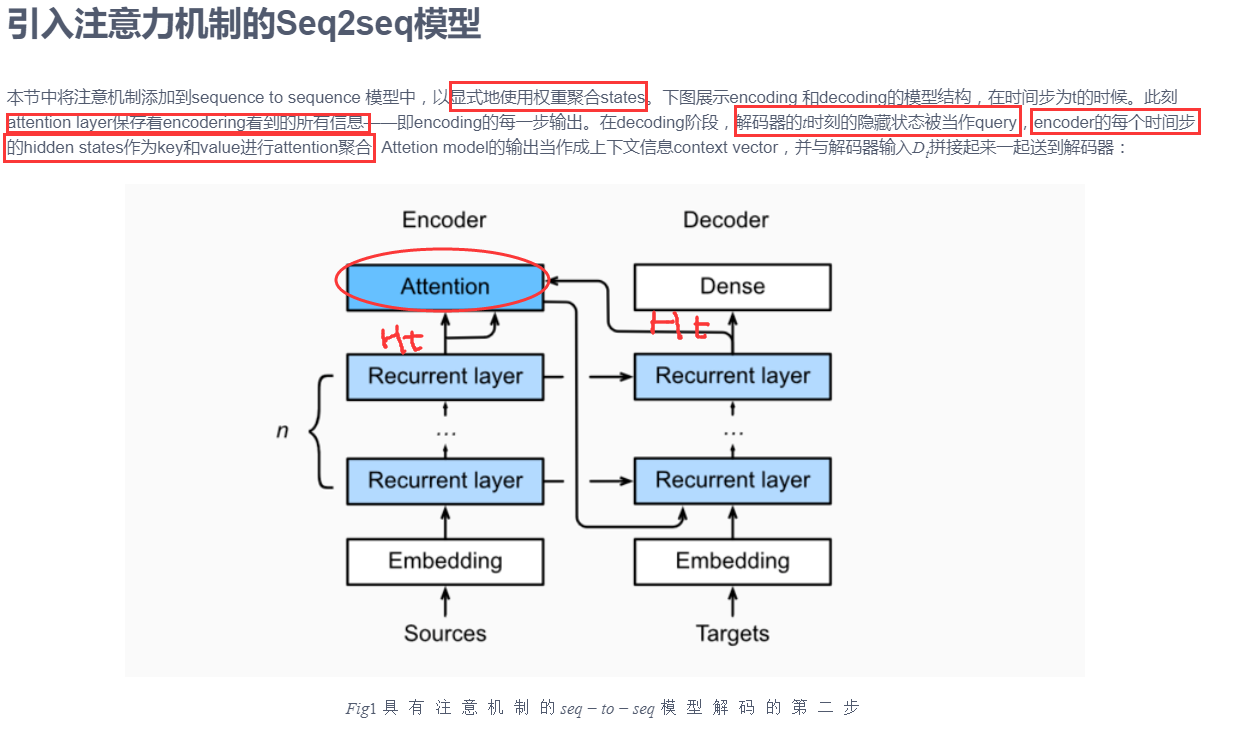
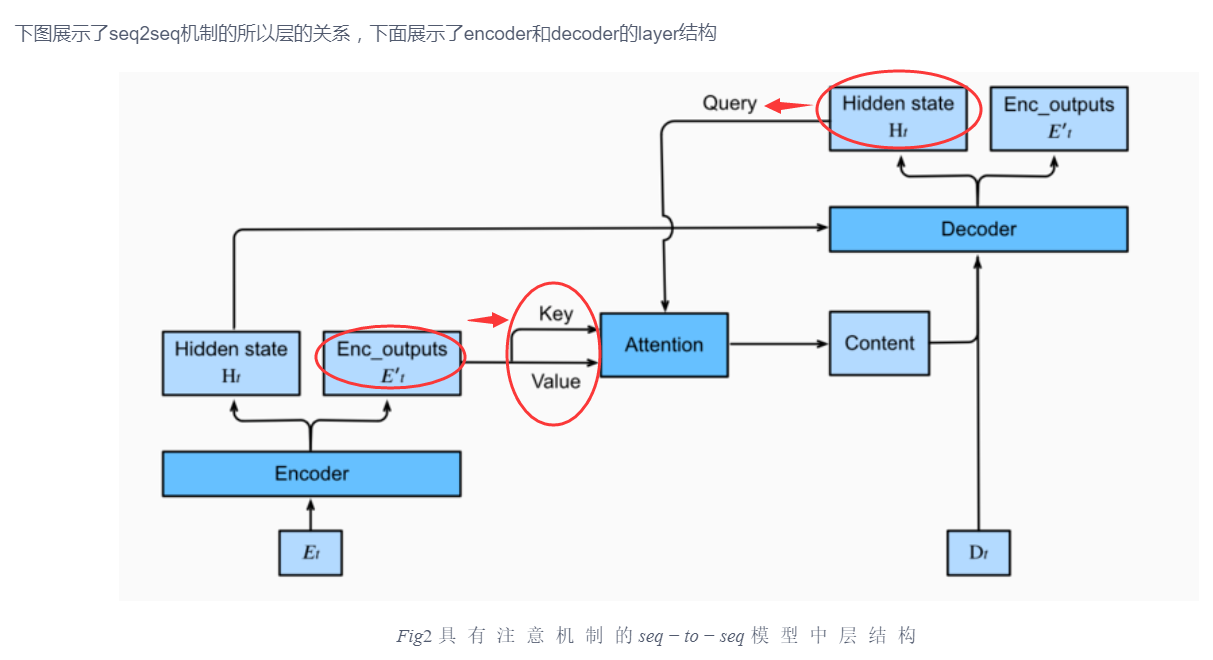
2.2.2. model
import sys sys.path.append('/home/kesci/input/d2len9900') import d2l
Encoding encoder
• the encoder of seq2seq with attention mechanism is the same as Seq2SeqEncoder in the previous chapter.
Encoder decoder
• we added an MLP attention layer (mlpattentity) with the same hidden size as the LSTM layer in the decoder. Then we initialize the decoder state by passing three parameters from the encoder:
1.the encoder outputs of all timesteps: each state output by the encoder is used in the memory part of the attachment layer, with the same key and values;
2.the hidden state of the encoder's final timestep: the hidden state of the last time step of the encoder, which is used to initialize the decoder's hidden state;
3.the encoder valid length: the effective length of the encoder, by which the layer will not consider the padding in the encoder output
• at each time step of decoding, we use the output of the last RNN layer of the decoder as the query of the attention layer. Then, the output of the attention model is connected with the input embedding vector and input to the RNN layer. Although the hidden state of RNN layer also contains the historical information from decoder, the output of attention model explicitly selects the encoder output within enc_valid_len, so that the attention mechanism will exclude other irrelevant information as much as possible.
Seq2SeqAttentionDecoder:
class Seq2SeqAttentionDecoder(d2l.Decoder): def __init__(self, vocab_size, embed_size, num_hiddens, num_layers, dropout=0, **kwargs): super(Seq2SeqAttentionDecoder, self).__init__(**kwargs) self.attention_cell = MLPAttention(num_hiddens,num_hiddens, dropout) self.embedding = nn.Embedding(vocab_size, embed_size) self.rnn = nn.LSTM(embed_size+ num_hiddens,num_hiddens, num_layers, dropout=dropout) self.dense = nn.Linear(num_hiddens,vocab_size) def init_state(self, enc_outputs, enc_valid_len, *args): outputs, hidden_state = enc_outputs # print("first:",outputs.size(),hidden_state[0].size(),hidden_state[1].size()) # Transpose outputs to (batch_size, seq_len, hidden_size) return (outputs.permute(1,0,-1), hidden_state, enc_valid_len) #outputs.swapaxes(0, 1) def forward(self, X, state): enc_outputs, hidden_state, enc_valid_len = state #("X.size",X.size()) X = self.embedding(X).transpose(0,1) # print("Xembeding.size2",X.size()) outputs = [] for l, x in enumerate(X): # print(f"\n{l}-th token") # print("x.first.size()",x.size()) # query shape: (batch_size, 1, hidden_size) # select hidden state of the last rnn layer as query query = hidden_state[0][-1].unsqueeze(1) # np.expand_dims(hidden_state[0][-1], axis=1) # context has same shape as query # print("query enc_outputs, enc_outputs:\n",query.size(), enc_outputs.size(), enc_outputs.size()) context = self.attention_cell(query, enc_outputs, enc_outputs, enc_valid_len) # Concatenate on the feature dimension # print("context.size:",context.size()) x = torch.cat((context, x.unsqueeze(1)), dim=-1) # Reshape x to (1, batch_size, embed_size+hidden_size) # print("rnn",x.size(), len(hidden_state)) out, hidden_state = self.rnn(x.transpose(0,1), hidden_state) outputs.append(out) outputs = self.dense(torch.cat(outputs, dim=0)) return outputs.transpose(0, 1), [enc_outputs, hidden_state, enc_valid_len]
Now we can use the attention model to test seq2seq. In order to be consistent with the previous model, we use the same super parameters for vocab ﹐ size, embed ﹐ size, num ﹐ hiddens and num ﹐ layers. As a result, we get the same decoder output shape, but the state structure changes.
encoder = d2l.Seq2SeqEncoder(vocab_size=10, embed_size=8, num_hiddens=16, num_layers=2) # encoder.initialize() decoder = Seq2SeqAttentionDecoder(vocab_size=10, embed_size=8, num_hiddens=16, num_layers=2) X = torch.zeros((4, 7),dtype=torch.long) print("batch size=4\nseq_length=7\nhidden dim=16\nnum_layers=2\n") print('encoder output size:', encoder(X)[0].size()) print('encoder hidden size:', encoder(X)[1][0].size()) print('encoder memory size:', encoder(X)[1][1].size()) state = decoder.init_state(encoder(X), None) out, state = decoder(X, state) out.shape, len(state), state[0].shape, len(state[1]), state[1][0].shape
2.2.3. Training and prediction
Try a simple entertainment model by applying the same training super parameters and the same training loss. From the results, we can see that the additional attention layer does not bring significant improvement because of the relatively short sequence in the training data set. Due to the computational overhead of the attention layer of the encoder and decoder, this model is much slower than the seq2seq model without attention.
import zipfile import torch import requests from io import BytesIO from torch.utils import data import sys import collections class Vocab(object): # This class is saved in d2l. def __init__(self, tokens, min_freq=0, use_special_tokens=False): # sort by frequency and token counter = collections.Counter(tokens) token_freqs = sorted(counter.items(), key=lambda x: x[0]) token_freqs.sort(key=lambda x: x[1], reverse=True) if use_special_tokens: # padding, begin of sentence, end of sentence, unknown self.pad, self.bos, self.eos, self.unk = (0, 1, 2, 3) tokens = ['', '', '', ''] else: self.unk = 0 tokens = [''] tokens += [token for token, freq in token_freqs if freq >= min_freq] self.idx_to_token = [] self.token_to_idx = dict() for token in tokens: self.idx_to_token.append(token) self.token_to_idx[token] = len(self.idx_to_token) - 1 def __len__(self): return len(self.idx_to_token) def __getitem__(self, tokens): if not isinstance(tokens, (list, tuple)): return self.token_to_idx.get(tokens, self.unk) else: return [self.__getitem__(token) for token in tokens] def to_tokens(self, indices): if not isinstance(indices, (list, tuple)): return self.idx_to_token[indices] else: return [self.idx_to_token[index] for index in indices] def load_data_nmt(batch_size, max_len, num_examples=1000): """Download an NMT dataset, return its vocabulary and data iterator.""" # Download and preprocess def preprocess_raw(text): text = text.replace('\u202f', ' ').replace('\xa0', ' ') out = '' for i, char in enumerate(text.lower()): if char in (',', '!', '.') and text[i-1] != ' ': out += ' ' out += char return out with open('/home/kesci/input/fraeng6506/fra.txt', 'r') as f: raw_text = f.read() text = preprocess_raw(raw_text) # Tokenize source, target = [], [] for i, line in enumerate(text.split('\n')): if i >= num_examples: break parts = line.split('\t') if len(parts) >= 2: source.append(parts[0].split(' ')) target.append(parts[1].split(' ')) # Build vocab def build_vocab(tokens): tokens = [token for line in tokens for token in line] return Vocab(tokens, min_freq=3, use_special_tokens=True) src_vocab, tgt_vocab = build_vocab(source), build_vocab(target) # Convert to index arrays def pad(line, max_len, padding_token): if len(line) > max_len: return line[:max_len] return line + [padding_token] * (max_len - len(line)) def build_array(lines, vocab, max_len, is_source): lines = [vocab[line] for line in lines] if not is_source: lines = [[vocab.bos] + line + [vocab.eos] for line in lines] array = torch.tensor([pad(line, max_len, vocab.pad) for line in lines]) valid_len = (array != vocab.pad).sum(1) return array, valid_len src_vocab, tgt_vocab = build_vocab(source), build_vocab(target) src_array, src_valid_len = build_array(source, src_vocab, max_len, True) tgt_array, tgt_valid_len = build_array(target, tgt_vocab, max_len, False) train_data = data.TensorDataset(src_array, src_valid_len, tgt_array, tgt_valid_len) train_iter = data.DataLoader(train_data, batch_size, shuffle=True) return src_vocab, tgt_vocab, train_iter embed_size, num_hiddens, num_layers, dropout = 32, 32, 2, 0.0 batch_size, num_steps = 64, 10 lr, num_epochs, ctx = 0.005, 500, d2l.try_gpu() src_vocab, tgt_vocab, train_iter = load_data_nmt(batch_size, num_steps) encoder = d2l.Seq2SeqEncoder( len(src_vocab), embed_size, num_hiddens, num_layers, dropout) decoder = Seq2SeqAttentionDecoder( len(tgt_vocab), embed_size, num_hiddens, num_layers, dropout) model = d2l.EncoderDecoder(encoder, decoder) d2l.train_s2s_ch9(model, train_iter, lr, num_epochs, ctx)

